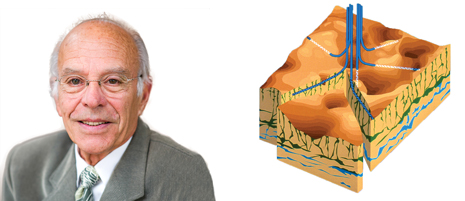Innovative thinkers
Horizontal wells: A standard for today
|
The advent of horizontal drilling, combined with hydraulic fracturing, is revolutionary, to say the least. Despite the mainstream belief that fracing is a new practice, it is actually horizontal drilling that is a more recently developed technology.
The first horizontal, industrial well was spudded in 1982 by Elf Aquitaine, now Total, in the Italian waters of the Adriatic Sea. Rospo Mare field held heavy, viscous oil, 11-12°API, and was from a “fractured and karstified carbonate reservoir that was uneconomical with a vertical well,” said Andre Jourdan, leader of the Elf Aquitaine team that drilled the well. Up until that time, effective, economical horizontal drilling had been a difficult practice, but Jourdan’s team was ordered to drill, and produce, horizontally. An eager man with a “hunger for adventure,” the Marseille native and civil engineer applied for a job that would offer an opportunity to work abroad, and he found it with drilling contractor Forasol. His ascent to management led to a move to southwestern France, heading an operational base of rigs and equipment maintenance, crew rotation, operator contact, and accounting. He later took stints in Libya’s desert, as well as offshore France and Gabon, aboard an experimental drilling ship. Jourdan joined Elf Aquitaine in 1969. “I just wanted to ‘cross the border,’ and learn more about oil and gas exploration and production,” Jourdan said. The Horizontal Drilling Project in 1980 was conducted in association with the French Petroleum Institute. Jourdan was involved for more than a decade. “It took quite a long time to drill the 2,000-ft well at high angle, inside the reservoir,” Jourdan said. “When you go from vertical to horizontal, you wonder about the impact that high-angle holes may have on torque, drags, weight-on-bit, drill pipe buckling, borehole stability, cleaning, and so on.” With regard to directional surveys, there was no MWD for an 8.5-in hole, so Jourdan had to use wireline-type tools, which meant they had to stop rotating, and then pump-retrieve the tool. “This was time-consuming, and risked stuck pipe.” These were the major problems that Jourdan’s team had to solve, hour-by-hour, with close, permanent supervision to anticipate the wellbore behavior. “My team and I did not get much sleep, and you can imagine our excitement, when we succeeded in running the liner to bottom,” Jourdan exclaimed. Jourdan’s enthusiasm was spurred even further, when he was told just a few months later, that the well was producing several times more than the vertical wells. “A lot of the problems we faced back then are solved today, due to the development made in the area of MWD-LWD measurement, and in the area of steerable drilling systems. I was convinced that there will be a great future for this technology.” Rospo Mare was launched at the prompting of reservoir engineers, not only for solving that particular dilemma, but also because mathematical modelling had shown that this technology could be used successfully for many other reservoirs. After the Rospo Mare success, Jourdan served as advisor for other operators. He spoke at conferences as an SPE Distinguished Lecturer in 1990-1991, and also earned the prestigious SPE “Drilling Engineering Award.” Companies soon began to employ those same tactics for horizontal wells worldwide. Less than three decades later, the shale code was cracked, and American companies engaging these same horizontal drilling tactics that Jourdan and his team started triggered a renaissance of unconventional oil and gas production. In 1991, Jourdan’s paper was titled “Horizontal wells, a standard for tomorrow.” “And today, the oil industry can say: ‘Horizontal wells, what else?!’” |
- Coiled tubing drilling’s role in the energy transition (March 2024)
- Shale technology: Bayesian variable pressure decline-curve analysis for shale gas wells (March 2024)
- Digital tool kit enhances real-time decision-making to improve drilling efficiency and performance (February 2024)
- E&P outside the U.S. maintains a disciplined pace (February 2024)
- Prices and governmental policies combine to stymie Canadian upstream growth (February 2024)
- U.S. operators reduce activity as crude prices plunge (February 2024)
- Applying ultra-deep LWD resistivity technology successfully in a SAGD operation (May 2019)
- Adoption of wireless intelligent completions advances (May 2019)
- Majors double down as takeaway crunch eases (April 2019)
- What’s new in well logging and formation evaluation (April 2019)
- Qualification of a 20,000-psi subsea BOP: A collaborative approach (February 2019)
- ConocoPhillips’ Greg Leveille sees rapid trajectory of technical advancement continuing (February 2019)



